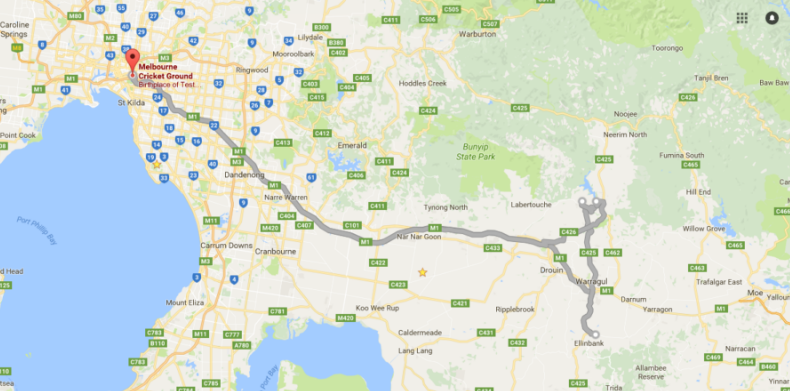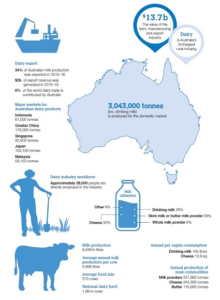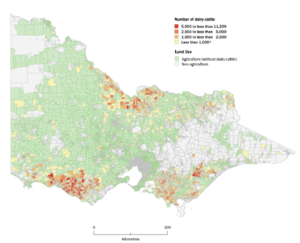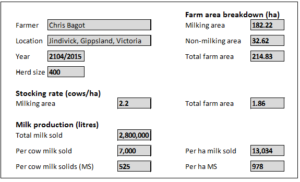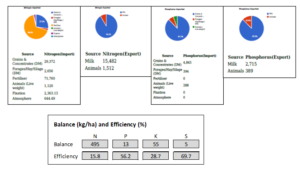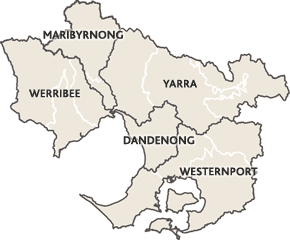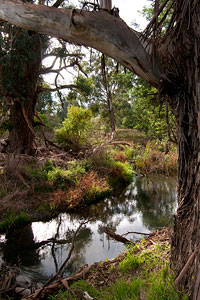Itinerary
| 7:45am | Meet outside gate 3 at the Melbourne Cricket Ground (MCG) |
| 8:00am | Depart MCG via coach and travel to Ellinbank Dairy Centre of Excellence |
| 9:30am | Arrive at Ellinbank Dairy Centre of Excellence |
| 10:00am | Overview of Australian dairy industry and of the Research facility (Bruce Weston, Centre Leader; Dr. Bill Wales) |
| 10:30am | View research facilities and dairyshed. Presentations by various scientists and staff |
| 12:15pm | BBQ Lunch |
| 1:00pm | Travel to Chris Bagot’s dairy farm |
| 1:30pm | Presentations by Chris Bagot, Pat Bloye (dairy consultant), Gabby Hakim (consultant engineer) |
| 3:00pm | Travel to Tarago Reservoir Park |
| 3:15pm | Melbourne water presentation (Paul Pearson and Louise Kerford) |
| 3:45pm | Depart Tarago Reservoir |
| 5:15pm | Arrive MCG |
Location of Victoria’s dairy farms
Predominantly in the north, south west and Gippsland regions (Figure 1). The northern region is dominated by irrigated farms. The south west dairy region is largely rainfall based, but augmented by use of ground water. The Gippsland region is rain-fed in South and West Gippsland, but with significant irrigation to the east.
Main Dairy Regions in Victoria
Click for larger image
Five main feeding systems
Five main feeding systems
Australian dairy farmers choose to use one of five main feeding systems on their farms:
- Pasture + other forages + low grain/concentrate feeding
(Grazed pasture + other forages + up to 1.0 tonne grain/concentrates fed).
- Pasture + other forages + moderate-high grain/concentrate feeding
(Grazed pasture + other forages + more than 1.0 tonne grain/concentrates fed).
- Pasture + partial mixed ration (PMR) ± grain/concentrate feeding
(Pasture grazed most or all of year + PMR on feed pad ± grain/concentrates).
- Hybrid system
(Pasture grazed for < 9 months/year + PMR on feed pad ± grain/ concentrates fed).
- TMR system
(Zero grazing. Cows housed and fed total mixed ration)
Structure of Victoria’s dairy industry
- 4,127 licensed dairy farms in Victoria, evenly distributed between the three regions.
- Average herd size went from 167 cows (1999-00) to 261 (2013-14); a 56% increase
- Trend towards large farms of over 1,000 cows; large herd farms are currently 6% of the industry but provide 28% of production.
- About 10,600 people employed in dairy production and a further 9,300 people employed in dairy processing in Victoria.
Site Visit 1
Ellinbank Dairy Centre of Excellence
The Agriculture Victoria Ellinbank Centre is set on the edge of the beautiful and ancient Strzelecki Ranges in the middle of prime dairying country. It occupies 217 hectares comprising the main building complex, a research farm, modern research dairy, animal research complex, laboratories, workshops and herd of 450 Holstein-Friesian dairy cows. (http://agriculture.vic.gov.au/agriculture/dairy)
The Ellinbank Centre is home to the National Centre for Dairy Research and Development which aims to develop innovative farming systems for greater economic value and environmental benefit. Additionally, the Centre supports regional and state agricultural industries by providing extension and regulation services such as management of invasive plants and animals, animal health and welfare response, extension and support for the dairy, meat and wool industries and emergency response and recovery for animal and plant disease as well as for drought, fire and flood.

National Dairy Research and Development Centre
The facility at Ellinbank was established in 1951 as an agricultural research station and has provided research and extension services to the dairy industry for over 60 years.
Much of the research undertaken has focused on improving grazing-based dairy production systems including soil and pasture nutrient requirements, forage evaluation, animal genetics and production, supplementary feeding strategies, farm profitability and reducing environmental impacts.
Research facilities include a technically advanced dairy, a number of experimental feeding facilities and state of the art greenhouse gas chambers and calorimeters to comfortably house dairy cows.
Research activities are fit for purpose and involve small to large component and systems studies, including research on commercial dairy farms for regional, state and national scale projects.
Important contributions to dairy production systems nationally and internationally include new knowledge and tools that improve grazing rotation systems, grain supplementary feeding, partial mixed rations and their effect on rumen function, soil test development and fertiliser requirements, quantification of animal and farm nutrient use efficiencies and soil chemical, physical and biological properties, physiology of heat tolerance in lactating dairy cows, identification of genetic markers and development of genomic breeding values for improved feed conversion efficiency, pasture agronomy and feed value indices for improved forages, nutritional abatement of enteric methane emissions, as well as nutrient loss and dairy environmental management assessment.
Site Visit 2
Chris Bagot Farm
The Bagot dairy operation located on Petschack Road, Jindivick and is running around 400 cows. There is a future plan to milk up to 600 cows commencing spring (September 2016). The farm milking area is approximately 182 hectares and the property is undulating with two main soil types (Figure 2). There are many waterways running through the property which connect to the Tarago Reservoir.
In addition to the home farm, there is a turnout block nearby that is used for dry cows. Young stock are also kept off the milking area. The nutrient budget has been developed based on the 182 ha hectare milking area. The calving date for the farm in 2014/2015 was in April, with a future date to calve at the 1st of June.
Most of the waterways and drains have been fenced to exclude cattle. Fencing helps to reduce the impact of dairy cows defecating and eroding the stream banks. Fertiliser application (including effluent) aims to avoid wet areas on the farm including a buffer around waterways.
The nutrient budget developed for the 182 ha hectare milking area reflects the feed and fertilizer inputs and milk and animal exports (kg nutrient) for the 2014/15 season.
Pat Boyle (Farm Manager, Chris Bagot’s Farm)
Pat Bloye is Farm Manager on Chris Bagot’s farm. He received his agriculture science degree from La Trobe University, Victoria. Pat worked as an extension officer with the Victorian state government for two years during which he was involved in all aspects of pasture management and worked with farmers across the state in Gippsland, northern Victoria and South West Victoria. He has held his current position for eight months. Pat will describe grazing and pasture management practices on Chris Bagot’s farm.
- Pat Bloye (2016), Weed Control and Growing Forage Cereals for Winter Feed, How Now Gippy Cow, April 2016;
- Pat Bloye (2014), Research demystifying endophytes, The Australian Dairyfarmer, September-October;
- dairytas.com.au/files/home/tassie_dairy_news_201406.pdf
- http://www.abc.net.au/news/2015-11-27/hay-fire-drought-bail-bushfire-crops-grain/6979694
Gabby Hakim (AgVet Projects Consultant)
Trained in agricultural science, Gabriel began his career in mastitis research over 27 years ago. He is well known throughout the Australian dairy industry and has an intimate understanding of its needs and workings; from the grass roots dairy farmer through to the Government and commercial sectors.
Gabriel has trained farmers, students, veterinarians, and milk harvesting technicians in areas such as mastitis control, milk quality, dairy hygiene, refrigeration, milking machine performance, and their inter-relationships.
Gabriel was the National Aftermarket and Service Manager for DeLaval Australia and for 8 years owned and managed a milking machine dealership (Dairy Equipment Specialists). He had key involvement in the invention, development and commercialisation of the Yard Blaster yard wash system, the company he still owns today. The Yard Blaster has now become the preferred method of cleaning dairy yards in Australia.
In recent years Gabriel has focused on energy efficiency and sustainable energy technologies and how they may be best utilised in the dairy industry. At the practical level, he has developed a dairy farm energy assessment tool for the industry, trains and mentors energy assessors and provides advice on evaluating technology options. He also designed the Green Cleaning project’s low temperature, energy efficient, re-use cleaning system for milking machines.
Currently, Gabriel is developing energy efficient and integrated technologies that will see large (and small) dairies operate with zero net energy. The 600-cow Bagot dairy at Jindivick will use about 40-50% less energy than a similar-sized dairy. And, the electricity it will use will be from renewable energy sources with zero greenhouse gas emissions.
Gabriel Hakim’s contact details are:
AgVet Energy
PO Box 1390
Warragul 3820
AUSTRALIA
p: +61 407 358 399
AgVet Energy is a division of AgVet Projects Pty Ltd
Site Visit 3
Tarago Reservoir – Melbourne Water
Melbourne Water is owned by the Victorian Government. We manage water supply catchments, treat and supply drinking and recycled water, remove and treat most of Melbourne’s sewage, and manage waterways and major drainage systems in the Port Phillip and Westernport region.
Our city has some of the highest quality drinking water in the world. As the wholesaler of Melbourne’s drinking water, we are responsible for managing the catchments, treating water and transferring it to our retail and regional water customers who in turn supply water to over 4 million people in individual homes and businesses.
Collecting and harvesting water
Water catchment areas in the north and east of Melbourne capture rainfall and direct it into our major storage reservoirs. Most of our drinking water comes from protected catchments with limited public access, so it is very high quality to begin with.
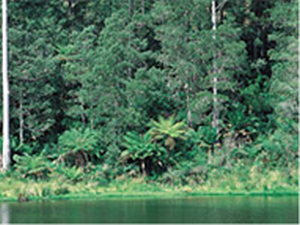
Storing water
Water rests in our storage reservoirs for up to five years, which helps improve its quality.
Our 11 storage reservoirs are interconnected, making our water supply system very flexible. Water is transferred around the system to manage it in the best way possible, such as moving water out of a reservoir so it can fill up during heavy rainfall, or directing less water to treatment plants that cost more to operate.

Treating water
After leaving our storage reservoirs, water is treated at our treatment plants to meet water quality requirements and is safe to drink.
Most of our water needs very little treatment since it comes from protected catchments. Water from open catchments is fully treated to make sure it also meets quality guidelines.
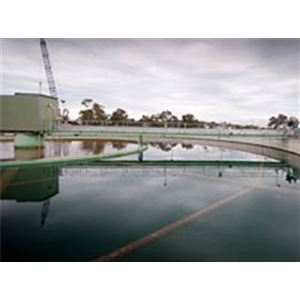
Transferring water to homes and businesses
After treatment, water flows through large pipes to 38 smaller service reservoirs located around suburban Melbourne service reservoirs. These range in capacity from 2 to 250 million litres, and hold water for a few days to ensure a constant water supply even when demand is high. These service reservoirs are often in elevated areas so water can be transferred via gravity, which is less costly and power-intensive than pumping water.
From our service reservoirs, water flows through smaller pipes to our customers – the metropolitan and regional retail water businesses, who own thousands of kilometres of pipes that carry the water in a web-like network to every home, school and business across Melbourne.

Monitoring water quality
Throughout the water supply system we test for over 100 substances. This ensures our water meets safety and quality requirements set by the Department of Health and Human Services, Australian Drinking Water Guidelines and our bulk water supply agreements with the retail water companies.
Our sophisticated monitoring and treatment processes make sure Melbourne’s drinking water meets very high standards.
Tarago Reservoir
Tarago Reservoir supplies Westernport and Mornington Peninsula. The dam was completed in 1969 and enlarged in 1971, and is constructed from rockfill with a clay core.
Tarago Key facts
- Catchment area: 11,400 hectares
- Surface area: 360 hectares
- Total capacity: 37,580 megalitres
- Dam height: 34 metres
- Dam length: 300 metres

Threats to the health of our rivers
The Port Phillip and Westernport region has different types of land, from the mountainous, forested areas upstream to the farmland and urban areas downstream. The condition of rivers and creeks deteriorate further downstream as land is used more intensively towards the city centre, changing them greatly from their natural state.
Westernport catchment
Covers 3,721 square km and contains 2,232 km of rivers and creeks. The landscape is varied and includes hilly regions , flat, undulating terrain, and the marine environment of Western Port and its islands.
Most of the catchment is modified to support rural and green wedge land uses, though there are still some significant environmental values:
- primary industries include dairying, beef production, poultry, horticulture and quarrying
- urban, industrial and tourist areas and lifestyle and hobby farms make up a smaller proportion
- some forested areas remain in the upper catchment, French Island and the Mornington Peninsula
Upper Bunyip and Tarago system
The major waterways are largely within State Forest and have remained in a mostly natural state.
Upper forested and rural waterways have multiple uses such as water supply, farming, lifestyle and recreational activities like fishing and picnicking.
Significant animal species are present in this system, including azure kingfishers, Australian grayling, Warragul borrowing crayfish and a healthy platypus population.
Challenges for waterway health include managing environmental flows, connecting habitat along waterways and balancing water supply and rural community access and use.
Melbourne Waterway Research-Practice Partnership
Water quality research in Tarago catchment
Water quality monitoring and field experiments are currently taking place within the Tarago Catchment, focussing on two main objectives:
- Developing a microbial pollutant source-tracking method that allows identification and prioritisation of pollutant sources within the catchment.
- Assessing the pollutant-removal performance of vegetated stream buffers that have been established on agricultural land.
Microbial source tracking in the Tarago reservoir catchment
Microbial source tracking is a tool used to predict sources of microbial pollution and associated health risks in water systems. This will be achieved using Microbial community fingerprinting which involves a set of biological techniques that can be used to quickly profile the diversity of a microbial community in a specific pollutant source.
The microbial fingerprint of pollutant sources, such as human and animal feces and agricultural runoff, is then compared with the microbial fingerprint of water entering the reservoir. This method will assist in understanding the pollutant sources that play a role in the contamination of water at Tarago, and facilitate more effective targeted solutions.
Effectiveness of vegetated stream buffers
The Tarago catchment hosts a large number of vegetated stream buffers on private agricultural land, established with a view to mitigating the export of pollutants in runoff. The main objectives of this part of the project are to:
- Determine how effective these buffers are at removing suspended, dissolved and microbial pollutants from runoff.
- Understand important processes, with specific focus on concentrated flow bypassing and the impact of vegetation community structure.
This will be achieved with a monitoring regime comparing buffered and unbuffered catchments. This will be complimented with direct runoff sampling experiments.
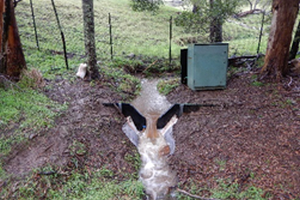

Presenter profiles
(http://agriculture.vic.gov.au/agriculture/dairy/dairy-science-and-research/dairy-researcher-profiles)
- Kerry Stott – Kerry an agricultural economist who has experience in market intelligence and post-farm research relevant to the global wool industry, and in on-farm research relevant to Victorian agriculture more generally
- Bill Wales – Bill is the dairy research manager and has extensive experience in developing feeding systems based on partial mixed rations, nutritional manipulation to mitigate methane production, developing genetic markers for feed efficiency in dairy cows and modelling dairying systems.
- Josie Thornhill – Josie is undertaking a PhD at the University of Melbourne researching physiology of heat tolerance in lactating dairy cows. Josie is also involved in experiments using novel strategies to breed dairy cattle for adaptation and reduced methane emissions.
- Kevin Kelly – Kevin has a broad knowledge of irrigated pastures, forage crop agronomy and measurement of nitrous oxide emissions from soils. Kevin has conducted research on grazing management, pasture species/cultivar evaluations, effects of pasture renovation on productivity, nitrogen losses associated with fertiliser and manure applications and water use of irrigated forages.
- Leah Marrett – Leah is involved in the identification of genetic markers and genomic breeding values for improved feed conversion efficiency, reduced methane emissions and improved heat tolerance in lactating cows. Leah also investigates the physiology of feed efficiency and heat tolerance, the use of partial mixed rations and their effect on rumen function and milk production.
- Marlie Wright – Marlie is currently undertaking a PhD with The University of Melbourne exploring individual cow variation in feed intake and milk production as a result of management decisions around the form and type of supplements offered to grazing dairy cows. As part of this PhD, Marlie travelled to Teagasc, Moorepark Ireland for two months to investigate the n-alkane technique to estimate intake in pasture based systems with the plan to apply this technique to research investigating partial mixed ration feeding systems.
- Matthew Deighton – Matthew works in the area of pasture and forage agronomy with the aim of improving the quality and quantity of forages on dryland dairy farms. Matt also has experience in determining ruminant methane emissions as well as a wide range of ruminant nutrition-based research. He has worked at the Irish Agricultural Research Authority, Teagasc in Ireland and with AgResearch at Palmerston North, New Zealand.
- Peter Moate – Peter was the first Australian researcher to measure methane emissions from grazing dairy cows and he conducted important research which demonstrated the efficacy of monensin anti-bloat capsules. He leads research investigating nutritional abatement of enteric methane emissions from dairy cows.
- Richard Williams – Richard has extensive experience in measuring methane emissions from dairy cows, is responsible for managing the respiration chambers and SF6 tracer equipment and managing large data sets.
- Victoria Russo – Victoria is undertaking a PhD into the ruminal and production effects of diet changes in pasture based dairy cows. The work aims to help dairy farms find practical solutions for the production losses and health issues associated with diet changeover periods.
- Greg Morris– Greg is the dairy manager and a senior technical officer who coordinates farm operations and research requirements for access to paddocks, farm and research facilities as well as staff. Greg coordinates and overseas all research experiments that occur on the farm.
Biography
Sharon Aarons
Sharon has over 20 years of experience in grazed dairy systems research in Australia. Her research activities aim to improve nutrient management for production and environmental outcomes.
Her research programs have focused on quantifying nutrient use efficiency of dairy cows within grazing systems across Australia, investigating the environmental impacts of grazing on riparian zones and waterways, as well as terrestrial and aquatic biodiversity management, and quantifying spatial nutrient transfers through manure deposition in grazed systems.
In addition, Sharon’s projects aim to identify strategies that assist farmers to effectively integrate management of the environment within productive dairy enterprises. To this end communication and extension of research results to farmers and extension providers has been an integral part of her project activities.


